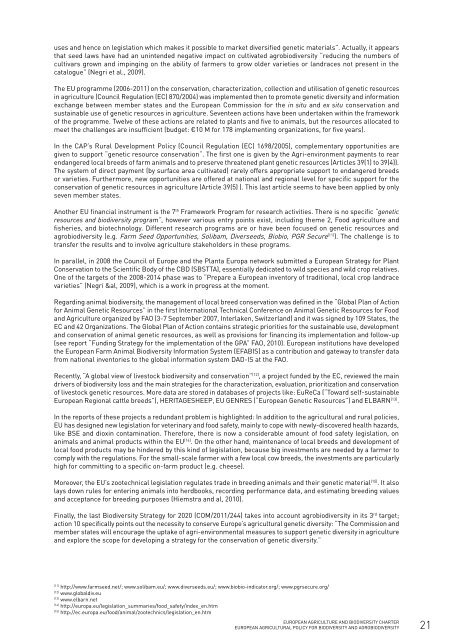agriculture - Reverse, European Project to Preserve Biodiversity
agriculture - Reverse, European Project to Preserve Biodiversity
agriculture - Reverse, European Project to Preserve Biodiversity
Create successful ePaper yourself
Turn your PDF publications into a flip-book with our unique Google optimized e-Paper software.
uses and hence on legislation which makes it possible <strong>to</strong> market diversified genetic materials”. Actually, it appears<br />
that seed laws have had an unintended negative impact on cultivated agrobiodiversity “reducing the numbers of<br />
cultivars grown and impinging on the ability of farmers <strong>to</strong> grow older varieties or landraces not present in the<br />
catalogue” (Negri et al., 2009).<br />
The EU programme (2006-2011) on the conservation, characterization, collection and utilisation of genetic resources<br />
in <strong>agriculture</strong> (Council Regulation (EC) 870/2004) was implemented then <strong>to</strong> promote genetic diversity and information<br />
exchange between member states and the <strong>European</strong> Commission for the in situ and ex situ conservation and<br />
sustainable use of genetic resources in <strong>agriculture</strong>. Seventeen actions have been undertaken within the framework<br />
of the programme. Twelve of these actions are related <strong>to</strong> plants and five <strong>to</strong> animals, but the resources allocated <strong>to</strong><br />
meet the challenges are insufficient (budget: €10 M for 178 implementing organizations, for five years).<br />
In the CAP’s Rural Development Policy (Council Regulation (EC) 1698/2005), complementary opportunities are<br />
given <strong>to</strong> support “genetic resource conservation“. The first one is given by the Agri-environment payments <strong>to</strong> rear<br />
endangered local breeds of farm animals and <strong>to</strong> preserve threatened plant genetic resources (Articles 39(1) <strong>to</strong> 39(4)).<br />
The system of direct payment (by surface area cultivated) rarely offers appropriate support <strong>to</strong> endangered breeds<br />
or varieties. Furthermore, new opportunities are offered at national and regional level for specific support for the<br />
conservation of genetic resources in <strong>agriculture</strong> (Article 39(5) ). This last article seems <strong>to</strong> have been applied by only<br />
seven member states.<br />
Another EU financial instrument is the 7 th Framework Program for research activities. There is no specific “genetic<br />
resources and biodiversity program”, however various entry points exist, including theme 2, Food <strong>agriculture</strong> and<br />
fisheries, and biotechnology. Different research programs are or have been focused on genetic resources and<br />
agrobiodiversity (e.g. Farm Seed Opportunities, Solibam, Diverseeds, Biobio, PGR Secure (11) ). The challenge is <strong>to</strong><br />
transfer the results and <strong>to</strong> involve <strong>agriculture</strong> stakeholders in these programs.<br />
In parallel, in 2008 the Council of Europe and the Planta Europa network submitted a <strong>European</strong> Strategy for Plant<br />
Conservation <strong>to</strong> the Scientific Body of the CBD (SBSTTA), essentially dedicated <strong>to</strong> wild species and wild crop relatives.<br />
One of the targets of the 2008-2014 phase was <strong>to</strong> “Prepare a <strong>European</strong> inven<strong>to</strong>ry of traditional, local crop landrace<br />
varieties” (Negri &al, 2009), which is a work in progress at the moment.<br />
Regarding animal biodiversity, the management of local breed conservation was defined in the “Global Plan of Action<br />
for Animal Genetic Resources” in the first International Technical Conference on Animal Genetic Resources for Food<br />
and Agriculture organized by FAO (3-7 September 2007, Interlaken, Switzerland) and it was signed by 109 States, the<br />
EC and 42 Organizations. The Global Plan of Action contains strategic priorities for the sustainable use, development<br />
and conservation of animal genetic resources, as well as provisions for financing its implementation and follow-up<br />
(see report “Funding Strategy for the implementation of the GPA” FAO, 2010). <strong>European</strong> institutions have developed<br />
the <strong>European</strong> Farm Animal <strong>Biodiversity</strong> Information System (EFABIS) as a contribution and gateway <strong>to</strong> transfer data<br />
from national inven<strong>to</strong>ries <strong>to</strong> the global information system DAD-IS at the FAO.<br />
Recently, “A global view of lives<strong>to</strong>ck biodiversity and conservation” (12) , a project funded by the EC, reviewed the main<br />
drivers of biodiversity loss and the main strategies for the characterization, evaluation, prioritization and conservation<br />
of lives<strong>to</strong>ck genetic resources. More data are s<strong>to</strong>red in databases of projects like: EuReCa (“Toward self-sustainable<br />
<strong>European</strong> Regional cattle breeds”), HERITAGESHEEP, EU GENRES (“<strong>European</strong> Genetic Resources”) and ELBARN (13) .<br />
In the reports of these projects a redundant problem is highlighted: In addition <strong>to</strong> the agricultural and rural policies,<br />
EU has designed new legislation for veterinary and food safety, mainly <strong>to</strong> cope with newly-discovered health hazards,<br />
like BSE and dioxin contamination. Therefore, there is now a considerable amount of food safety legislation, on<br />
animals and animal products within the EU (14) . On the other hand, maintenance of local breeds and development of<br />
local food products may be hindered by this kind of legislation, because big investments are needed by a farmer <strong>to</strong><br />
comply with the regulations. For the small-scale farmer with a few local cow breeds, the investments are particularly<br />
high for committing <strong>to</strong> a specific on-farm product (e.g. cheese).<br />
Moreover, the EU’s zootechnical legislation regulates trade in breeding animals and their genetic material (15) . It also<br />
lays down rules for entering animals in<strong>to</strong> herdbooks, recording performance data, and estimating breeding values<br />
and acceptance for breeding purposes (Hiemstra and al, 2010).<br />
Finally, the last <strong>Biodiversity</strong> Strategy for 2020 (COM/2011/244) takes in<strong>to</strong> account agrobiodiversity in its 3 rd target;<br />
action 10 specifically points out the necessity <strong>to</strong> conserve Europe’s agricultural genetic diversity: “The Commission and<br />
member states will encourage the uptake of agri-environmental measures <strong>to</strong> support genetic diversity in <strong>agriculture</strong><br />
and explore the scope for developing a strategy for the conservation of genetic diversity.”<br />
(11) http://www.farmseed.net/; www.solibam.eu/; www.diverseeds.eu/; www.biobio-indica<strong>to</strong>r.org/; www.pgrsecure.org/<br />
(12) www.globaldiv.eu<br />
(13) www.elbarn.net<br />
(14) http://europa.eu/legislation_summaries/food_safety/index_en.htm<br />
(15) http://ec.europa.eu/food/animal/zootechnics/legislation_en.htm<br />
EUROPEAN AGRICULTURE AND BIODIVERSITY CHARTER<br />
EUROPEAN AGRICULTURAL POLICY FOR BIODIVERSITY AND AGROBIODIVERSITY<br />
21



